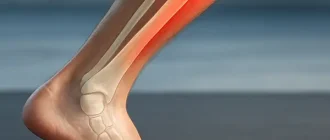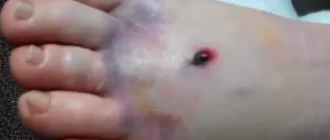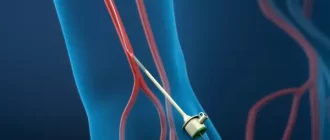Leg varicose veins are a serious and widespread feminine disease, to which it is important to pay attention from a young age. Read my article about the causes, symptoms and how to deal with this problem of leg veins.
In its initial stages, the disease rarely bothers patients. However, the presence of dilated veins, even if they do not bother yet, already carries a great danger to life, because at any moment the most dangerous complication – thrombophlebitis – can occur.
In case of varicose vein disease, damaged valves allow blood to enter the superficial venous system, resulting in an increase in pressure, which leads to their dilation. Blood flow slows, tissue oxygen supply is reduced, and ulcers occur.
See also: How to Get Rid of Spider Veins on Chest
Causes of varicose veins on legs
Causes of the disease:
- Heredity; hereditary vascular weakness
- Prolonged static strain
- sedentary lifestyle
- Taking hormonal drugs and hormonal disorders
- pregnancy
- leg injuries
- Lifting heavy weights, overloading (for example, a sudden start of vigorous exercise after years of a sedentary lifestyle)
- smoking
Read also: Painful Feet and Legs During Pregnancy
Who is at risk?
The risk group includes people both young and old:
- Those who wear high heels;
- sportswomen, whose activities are connected with a heavy load on legs (tennis, weightlifting, bodybuilding);
- professions that force you to stand on your feet for hours during the workday, to be at the wheel, on the computer hairdressers, salespeople, teachers, waiters and representatives of other professions who spend a lot of time standing;
- “sedentary” professions and those who are very fond of putting their leg over their leg;
- coffee and alcohol drinkers, because these foods dehydrate the body and thus clot the blood, making it harder for it to travel back to the heart.
Good to know: Herbs for Circulation in Feet
Symptoms of varicose veins on the legs

If you feel heavy in your feet by the end of the workday and your favorite shoes have become tight because of mild swelling, then these are already the first signs. Occasional cramps, pains in the calves should also alert you.
Visible to the eye changes in the veins usually start small – with the appearance of spider veins.
Later on irreversible processes occur in large veins, they come to the surface, their walls thin out in some places and they look nodular.
Nutrition and diet
A diet for varicose veins is a maximum of vegetables and fruits, a minimum of salty and smoked foods. A diet low in animal protein, fats and refined carbohydrates. Spicy food makes the blood thicker, which leads to blood clots. Vodka, cognac, and whiskey have a similar effect. It is advisable to eat as little meat as possible. It is not without reason that the Papuans and peoples of the Far East, who prefer vegetarian food, never suffer from this disease.
Include in your diet fish, fresh fruits and vegetables, foods rich in fiber, high in vitamin C and rutin. Of plant foods, all are useful. The ABC principle applies here, where A is carrots, B is leafy lettuce, and C is herbs and citrus fruits. To this list should be added two more very important vitamins that strengthen the walls of blood vessels. These are vitamin E, which is found in olive oil, and vitamin P, which is found in walnuts, green tea and rosehips.
Vitamins C and E, are components of collagen, the connective tissue of veins and venous valves. Germinated wheat and rye grains, as well as peas, beans and green onions enrich the veins with necessary nutrients and make them more elastic. Garlic occupies a special place.
Scientists have proven that garlic has a beneficial effect on the blood. This manifests itself in preventing the formation of blood clots in blood vessels – clots that obstruct or block the blood flow.
To summarize the effects of garlic on blood viscosity in nearly thirty scientific experiments, it can be summarized as follows: if you take garlic for a period of time, you can expect a 50% increase in intravascular clot dissolving. In addition to helping to dissolve blood clots, garlic also prevents platelets from enlarging and thickening, and thus forming clots.
Eat 2-3 cloves of garlic daily with your food. This helps to lower blood pressure, clean blood vessels from atherosclerotic deposits, strengthen their walls and prevent varicose veins, etc.
Prevention
If you have the initial signs of varicose veins, then compliance with fairly simple rules will help to slow down, and in some cases avoid its further development.
- Do not enjoy hot baths, sauna, prolonged exposure to the sun. All of the above reduces venous tone, leads to blood stasis in the lower extremities.
- You should move more. Regular exercise should help to strengthen the veins and improve circulation. Engagement in aerobics, jogging, swimming in a moderate mode promotes the recovery of your veins.
- Reduce weight. Particularly prone to this disease are people who suffer from excessive weight. There is more blood in the blood vessels of a full person than in a person of normal weight, so there is too much load on such vessels. The only advice we can give to overweight people in this situation is to lose weight and keep your weight in balance at all times.
- Do not wear tight clothes, stockings and socks with tight elastic bands, as this leads to compression of the veins. But supportive tights and stockings help prevent varicose veins to some extent.
- Alternate loads evenly, never staying in the same position for long periods of time.
- Don’t sit leg over leg! Throwing one knee over the other creates an obstruction to blood flow.
- Keep moving. Standing for long periods of time can cause varicose veins, because this interferes with normal blood flow. Try to move your weight if you have to stand for a long time. Prolonged sitting will also not do you any good: try to get up from time to time and move around the room or walk every half an hour.
- Exercise in the morning. Before going to bed and in the morning after waking up, twirl your toes and feet for 3-5 minutes each – this improves blood circulation in the lower extremities.
- Do not wear heels and tight shoes.
- Sprinkle your feet with cold water after work.
- Walk more in the dew and on the edge of bodies of water in summer.
If you are not affected by varicose veins but only prone to it, the daily self-massage with soft stroking and kneading of legs from bottom to top will be useful for prevention.
If you are already diagnosed with varicose veins, foot massages are contraindicated!
Lack of exercise and chronic constipation are factors contributing to varicose veins.
If you feel heavy legs in the evening after the working day, you should keep your legs elevated during sleep and rest. When you rest, read a book, or watch TV, put your legs up high. You can put a high pillow or a cushion.
If your work is accompanied by long sitting at the table or standing for a long time, you should change the position of your legs more often, walk on the spot and turn your feet.
After showering or taking a bath, rinse your feet with cold water. There are sports that are useful for this disease – this is primarily swimming, but also walking, light jogging, cycling, skiing.
Recreational and therapeutic exercises
A great benefit will come from the daily performance of special exercises:
- Raising on tiptoes. Starting position – stand straight, feet parallel to each other and pressed one to the other. On the count one – rise to your toes, on the count two – lower yourself to the starting position. Repeat 20-30 times.
- Lift (toes apart). Initial position – standing straight, heels together, toes apart. Raise to your toes on count one, and then lower to the starting position on count two. Repeat 20-30 times.
- Lift (heels apart). Initial position – stand straight, toes together, heels apart. You get the position with a clubfoot. On the count one – rise to your toes, on the count two – lower yourself to the starting position. Repeat 20-30 times.
- Another useful exercise is the “bicycle” from the supine position. It is very important – when performing this exercise, straighten your legs to the end.
You can perform these simple exercises even while doing everyday things (when you cook porridge or stand at the photocopier in the office). Stay healthy!
About the Author
Reyus Mammadli is the author of this health blog since 2008. With a background in medical and biotechnical devices, he has over 15 years of experience working with medical literature and expert guidelines from WHO, CDC, Mayo Clinic, and others. His goal is to present clear, accurate health information for everyday readers — not as a substitute for medical advice.







